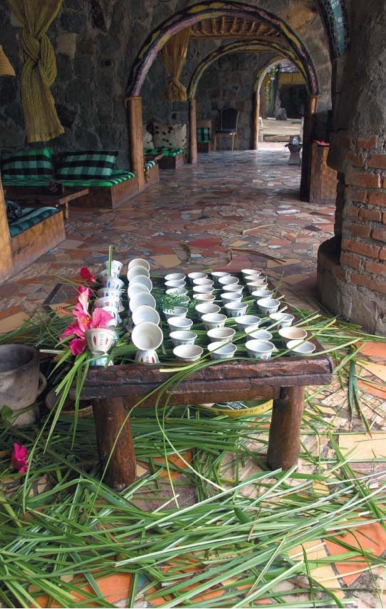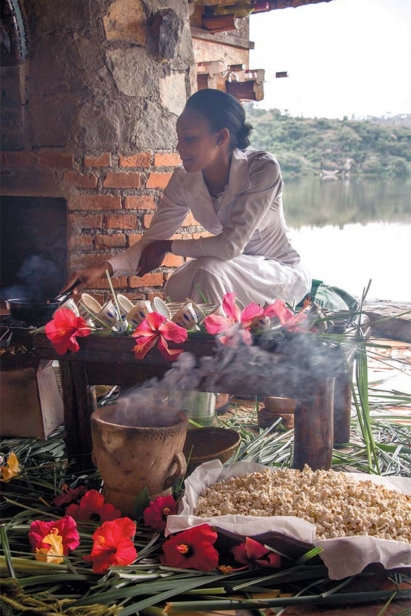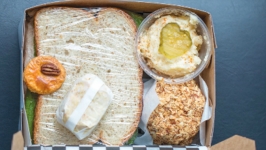In Ethiopia, Coffee Requires Community
Never Drink Alone
Smoke filled the room, bouncing gently off the tiled wall as a woman fanned a pot silently. Little birds perched in a tree right outside the open-air stone window frame, enticed by the smell of popcorn and roasted barley. They bobbed and chirped, tilting their heads as they watched the intricate ceremony.
Here, along the shores of Lake Kiroftu, about an hour and a half from Ethiopia’s capital city Addis Ababa, is the spot Ethiopians come to vacation, to enjoy the lake and the fresh air. During my visit, Lake Kiroftu had all the ease, calmness, elegance and serenity that Addis Ababa itself lacked.
Kuriftu Lodge Debre Zeyit isn’t just a local favorite—from the celebrity guest wall, a sunglasses-clad Muammar Gaddafi stared down at me, his cartoonish getup and stony expression contrasting sharply with the smiling hotel manager next to him in the picture. Earlier that morning, I’d stared at Gaddafi in my pre-coffee haze, trying to break through my mental fog and determine whether this was in fact the Libyan dictator. He was posing in the same spot I was heading to, probably on the way to the same daily event.
Further down the hall, I arrived in an open-air stone and brick enclave. Piles of green grass formed a bed on the floor, surrounding a small wooden table filled with cups. A woman in a traditional Ethiopian white dress placed pink flowers delicately around the grass and table, poking some through the small spaces between the perfectly tilted porcelain coffee cups. With her hair tied back and her long limbs extended from her seat on a pillow, the woman silently positioned everything exactly where it needed to be. To her left, she set out a basket full of fresh popcorn. She offered guests a tray of roasted barley to snack on. Meanwhile, a familiar smell emanated from a tiny charcoal stove, growing stronger as the coffee beans roasted. Once they were dark and shiny, she ground them down with a mortar and pestle.
She poured the brewed coffee out of a large clay pot into small white cups printed with red accents that matched the woven hem of her dress. As she handed me a coffee cup filled to the brim, I smelled the sprigs of the herb tena adam on the saucer. Then she offered me the customary heaping teaspoons of sugar (or in some regions, salt—but never milk).
Time ticked by as a crowd of hotel guests ebbed and flowed, drawn in by the earthy smell and drawn back out by the rocking chairs along the lakefront deck. We drank, chatting more as the caffeine awakened our brains and emboldened our conversations. I tried as hard as I could to finish a third cup (traditionally the lucky cup), but every cell in my body felt like it was vibrating. This was an abbreviated coffee ceremony—it only lasted for an hour.
In Ethiopia, coffee ceremonies are an important part of everyday life. A woman holds a ceremony three times per day (morning, noon and night), inviting neighbors, visitors, special guests and friends. Coffee ceremonies are as much about the community as the coffee—this is the setting for important discussions, making friends, spreading news. Performing the coffee ceremony is a position of pride—the coffee maker customarily receives endless praise for both her work and her coffee, since brews made from scratch all taste slightly different. Ceremonies can last up to three hours, effectively creating a daily schedule for the neighborhood.
The number-one rule of the coffee ceremony: It is never—ever—a solo activity.
This comes in stark contrast to my current coffee ritual. First thing in the morning, a shell of someone who closely resembles me shuffles into the kitchen and assembles some form of coffee. Within a matter of sips, I can feel my brain and my soul dripping slowly back into my body, and the person I recognize as myself suddenly appears. There is little joy in my daily habit, outside of the occasional ironic coffee cup. In Ethiopia, coffee is not used to wake up. It’s used to take advantage of the best parts of being awake.
Though I had never participated in this kind of coffee ritual before, something about it was familiar to me. My own love affair with coffee started out in a similar spirit, when I discovered the Starbucks in Morristown along the Green. A few times a month after school, my friends and I used to hang out there together, enjoying that gateway drug known as a Frappuccino. Back then, I rarely drank coffee alone. But once I entered the working world, with its ubiquitous if slightly depressing office coffee machines, coffee became an acceptable way to sneak a break, the fuel to keep powering through, an addiction.
In many ways, to visit Ethiopia is to revisit coffee’s past. The Oromo Valley was the birthplace of coffee sometime around the 10th century. According to local legend, a goat herder noticed his goats kicking and dancing after eating certain berries. He brought them to a local monastery in search of answers. The monks doused the red coffee berries with boiling water to kill them, but instead discovered that the newfound elixir gave them energy for longer devotionals. Fittingly, the birthplace of coffee was also the birthplace of civilization.
Lucy, our earliest known ancestor and the first adult to walk upright, was discovered in Hadar. She was an ape-human hybrid who lived 3.2 million years ago, standing all of three feet tall and lacking a tail. Her bones are on display, alongside several of the world’s earliest artifacts, in the National Museum of Ethiopia.
Revisiting the past is literal as well as figurative when it comes to Ethiopia. In September 2016, I rang in the new year in Addis Ababa— where they use a unique calendar and just welcomed 2009. On the afternoon of New Year’s Eve, my guide, Assefa Genetu, had a special destination in mind.
“We’re going to the Starbucks of Ethiopia,” he announced proudly. We drove through a city that had become familiar in a matter of days, past a mixture of standalone concrete buildings, some office high rises, wooden shacks with tin roofs in dirt lots. People walked down the street carrying roosters upside down by their legs and leading goats by ropes, preparing for the holiday.
Stepping through the doors of the family-owned ToMoCa revealed yet another side of Addis Ababa. There were shiny red coffee machines, staff in white lab coats and hair nets, glass coffee cups with matching saucers. In 1953, ToMoCa became the first coffee roasting company based in Addis Ababa, and it remains the most popular.
Every square foot of the small café had a different feel. There were men sitting at tables, silently reading the paper as TV news played overhead, reminding me strongly of the counter at any local New Jersey diner. The coffee bar, with its grinding machines and happy staff in white uniforms, felt like a 1950s soda fountain. A map of Ethiopia’s coffee regions decorated the wall, along with family photos. A Balzac quote over the door proclaimed, “When you drink a cup of coffee, ideas come in marching like an army.” A mild din of voices rose up in response to the grinding beans and hissing of espresso steam. Glass cups of black coffee floated by, while everyone claimed a space at a counter or a table. It wasn’t the chaos of New York City; it was a huddle of happy drinkers.
This was a more modern version of a coffee ceremony. At ToMoCa, there is no such thing as “to go.” This coffee isn’t fuel; it is a luxury. Most importantly, it isn’t an individual activity. I brought up this idea with Assefa, who seemed confused that people would make coffee for themselves and forgo the social aspect.
“You need to do the coffee ceremony with people in order to go back to the past,” Assefa explained to me, his politeness masking an underlying concern that I would ever drink coffee alone, like a pariah. Somewhere on its way to us in America, coffee’s purpose got lost.
The Arabian Peninsula starting cultivating coffee in the 15th century, getting credit in the western world for the delicacy once it reached Europe sometime in the 17th century. (“Café Arabica. That’s us,” Assefa said with a smile, placing his hand to his chest.) Coffee made its way to the New World in the 1600s, but it trailed woefully behind tea in popularity until a famous skirmish over taxes, which is when we became a coffee-drinking nation.
The name ToMoCa comes from an abbreviation of the Italian phrase torrefazione moderna café (“modern coffee roasting”). The Italians came to occupy Ethiopia in 1896, and then again from 1935 to 1936, due to the country’s fertile land and natural resources (like coffee berries).
Afterward, the Ethiopians actively tried to eradicate all outside influences the Italians left behind, but there were two things they couldn’t part with: espresso and spaghetti. There are still bits of Italian influence sprinkled throughout Addis Ababa, like the grand piazzas and elaborate statues that tower over the middle of wide roundabouts, but they have developed a distinctly Ethiopian twist (like the statue of Bob Marley, the Jamaican-born singer who considered Ethiopia his spiritual home, and the omnipresent donkeys carrying bales of hay and bundles of sticks).
The Holy Trinity Cathedral, the second most important house of worship in the country, was built to celebrate Ethiopia’s liberation from the Italians. On New Year’s Day, the city’s Orthodox Christian population shows up for an all-day mass. On New Year’s Eve, I watched priests in a circle chanting slowly to welcome in the New Year and all of its blessings. They sang for three and a half hours, accompanied only by a drum and a bell, using prayer sticks to hold themselves up when they got tired.
Addis Ababa, when pronounced correctly (with the emphasis on the first syllable of “Ababa”) means “the new flower.” The way most people pronounce it—with the emphasis on the second syllable—means “the new father,” which makes Ethiopians laugh. We have also, it seems, misinterpreted coffee over the years, with syrups, creamers, ice cubes, blenders, solitude.
On New Year’s Eve, I watched traditional Ethiopian dancers while enjoying shiro and injera at a local restaurant, Totot. After dinner, I headed back to my hotel. I ran to my balcony around midnight and watched a colorful, familiar fireworks display, cascading brightly over a city with very few streetlights. For a minute, I could have been anywhere in the world. I heard faint cheering off in the distance and then, only a few minutes later, that familiar aroma of coffee wafting through the air.
COFFEE, CLOSER TO HOME
It may be many years before I return to Ethiopia. Until then, I’ll be enjoying coffee and companionship at some of my favorite Garden State cafés.
EMPIRE COFFEE & TEA
338 Bloomfield St., Hoboken
201.216.9625
empirecoffeetea.com
Hoboken’s trendy coffee shops come and go just as quickly as—well, everything else in Hoboken, but Empire Coffee & Tea has been there forever. The coffee menu is just as eclectic and personalized as the shop, which always seems to have the perfect gift for someone in my life.
RED EYE CAFÉ
94 Walnut St., Montclair
973.509.3663
drinkredeyes.com
I haven’t found many establishments where a gourmet coffee list coexists with a menu that would draw you in on its own, but Red Eye Café does food and coffee equally well.
SMARTWORLD COFFEE
74 South St., Morristown
973.359.9800
smartworldcoffee.com
Morristown has always had plenty of coffee, but not many coffee shops. I like SmartWorld’s extensive and creative drink list, which covers all of your coffee needs and then some. Plus, the healthy food menu makes me feel better about ordering my white chocolate mocha with whipped cream.







